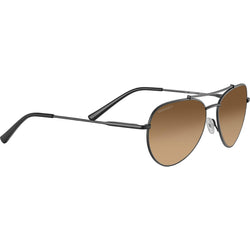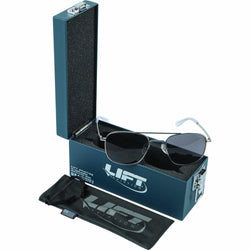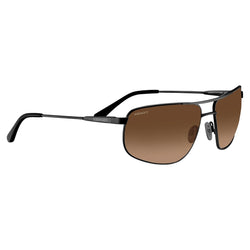In all your years of flying has anyone ever given you the green light to wear a pair of polarized sunglasses in the cockpit?
Probably not.
In fact, it is much more likely that you have been admonished to not fly wearing polarized frames.
But what if we told you that times are changing, technology has advanced, and you now have the option of choosing a pair of cockpit-friendly, digital-device compatible polarized sunglasses?
Wouldn’t it simplify things if you could just wear your everyday Terra firma shades up into the wild blue yonder? No more remembering to pack a separate pair of sunglasses and to switch to them for flight.
Today we will share exciting news about a visionary sunglasses brand that has brought polarized lenses to everywhere from the golf course to the ocean and now – to the cockpit.
To kick things off, let’s remind ourselves of what exactly polarized lenses are and how they differ from standard non-polarized options.
What are polarized sunglasses?
When light hits a flat horizontal surface (like water or snow), it is reflected back more intensely, and also in a horizonal direction. This type of light which is retransmitted in mainly one direction is said to be polarized.
The lenses of polarized sunglasses have a special laminated filter that blocks much of this powerfully magnified horizonal reflection and allows just the vertical light through.
The result is less blur, haze and glare. Objects appear more crisp and clean.
There are varying degrees of lens polarization. The more vertically oriented the polarization filter of a lens is, the less horizontal light can pass through.
How are non-polarized sunglasses different from polarized sunglasses?
Non-polarized lenses work by simply reducing the intensity of the light that passes through them and into our eyes. Basically, they just act as dimmers and make the light less bright.
Non-polarized lenses do not have the benefit of a filter to decrease the blur, haze and glare that comes from intense horizontal light reflecting off of flat surfaces.
What is the problem with wearing polarized sunglasses in the cockpit?
Traditional polarized lenses present an issue in the cockpit largely because of the way that their light-filtering technology interacts with digital devices.
A byproduct of the filtering is that it often makes it more difficult – if not nearly impossible – to read LED and LCD screens on devices like cell phones, tablets or instrument panels.
The filters also don’t play nice with existing anti-glare technology in the cockpit.
Can polarized sunglasses be worn by pilots?
Because of these issues, if you’ve been flying for a while, you have likely heard from just about everyone – us included – that polarized sunglasses are a no-go for pilots.
Generally speaking, that advice still stands, but we have found one notable exception that we’re excited to share with you:
The polarized lenses in Revo brand shades feature unique technology that other brands lack. This special tech makes Revo a polarized lens that we can finally recommend wearing in the cockpit.
What makes Revo polarized lenses different from other polarized lenses?
Of course you are naturally wondering what exactly sets Revo apart, and that is an excellent question.
Let’s start with a mini-history lesson, shall we?
Back in the early to mid-‘80s, Dr. Mitch Ruda was a NASA Astrophysicist and Optical Engineer. While working keeping satellite porthole windows safe from radiation, he had a serious aha moment.
What if that same special protective coating that kept NASA’s expensive tech safe could also be used to protect human eyes?
Like so many other NASA inventions that have been adapted to work here on Earth, the answer was ‘yes,’ and Revo was born.
NASA-based Light Management System Technology
The secret to Revo’s singular effectiveness lies in its ability to manage the full light spectrum. Revo has designed specialty lenses to combat blue light, glare and UV radiation while remaining digital-device friendly.
Blue Light
Revo lenses protect from the harmful effects of blue light, giving the wearer reduced eye fatigue and a decreased risk of future eye health problems.
Glare
We are all plenty familiar with the blinding glare that can envelop the cockpit. Revo lenses protect our eyes and reduce the strain, fatigue and squinting.
UV
The effects of UV radiation are bad enough on the ground, but we all know it only gets worse at altitude. How much worse? The FAA says that for every 1,000 feet of altitude increase, UV radiation exposure levels also rise by 5%.
That may not sound like all that much, but let’s do the math, shall we?
By the time you climb 10,000 feet, your exposure has increased by 50%.
Ascend 20,000 feet and your unprotected eyes are already being bombarded by double the radiation they were exposed to on the tarmac.
If that’s not enough to make you reach for a pair of 100% UVA, UVB and UVC protecting Revo shades, what is?
Digital Device-Friendly
We saved the best for last. Revo’s biggest, most impressive differentiating factor in its light management system is a proprietary ability to offer the benefits of polarization without hindering your ability to view your digital devices.
Phones, tablets, LCD/LED instrument displays – all the screens in the cockpit can still be easily viewed and read while wearing Revo polarized glasses.
Unique Lens Coatings
All Revo sunglasses start with a high-tech lens base. The lens is than sandwiched safely in between a series of specialty coatings.
The back side of the lens first receives a “back-surface protection coating” to help reduce reflections. A “hydrophobic coating” keeps water and sweat from lingering on the inside of the lens.
The top side of a Revo lens is given a “polarized film” to reduce glare and eye strain. Over the top of the film are 3-6 layers of “exclusive mirror coatings” – the secret NASA technology component. Finally, an “oleophobic coating” helps keep oil and fingerprints at bay.
Revo may not reveal all of their proprietary secrets, but it is clear that they have put a great deal of research, thought and care into crafting their high-performance lenses.
Ready to treat your eyes to a pair of Revo sunglasses?
Your eyes deserve a break. Shop Revo Sunglasses Online and find best styles and colors Revo has to offer. You just may find the shades your eyes have been waiting for.









1 comment
Dennis Korzhov
Just ordered a pair of Revo’s similar to the ones in the picture because of this article. Hope the author is right, because it was between a regular non polarized pair or these.